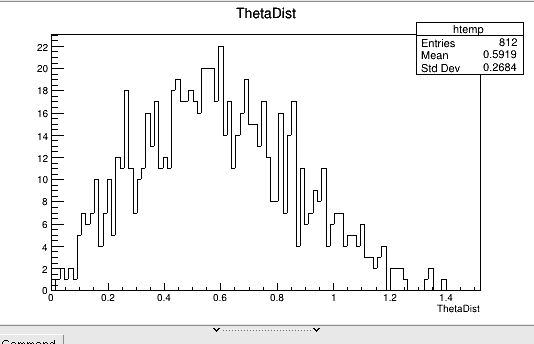Hi All,
I have managed to integrate the cosmic-ray library (CRY) into Geant4 and have run some first tests but it seems that the zenith angle distribution returned is incorrect. I seem to not be seeing a cos^2 distribution as expected. Does anyone have any ideas about this or has anyone experienced the same issue?

Best regards,
Sarah
Dear Sarah,
If the problem is not already answered then this may help, otherwise it will be helpful to others in future.
If you just plot the zenith angle distribution taking cosmic muons from CRY, then i believe you must be calculating the angle between the vertical down (0,0,-1) and the direction in which the particle is coming from CRY. From detector point of view you are actually considering that your detectors are lying horizontally, hence there is no solid angle correction applied. So if you want to see the fitting with cos^2 distribution then you have to apply solid angle correction, and then the fitting with m*cos^n will give the value of n close to 2.
Hope it clarifies your doubt.
If you had already got the correct distribution then it will be good if you post your solution also , because that will help others.
Regards,
Raman
Hello! How do you ensure that CRY outputs all the particles that can reach the detector you set up?Since CRY emits a lot of particles in its simulation of the real sky, Not all of these particles are what they want. How do you get all of CRY’s particles to the detector?
So far, many of the particles in my simulation that don’t fit the criteria still occupy the output of Eventid. In this case, if I want to get a certain number of particles to reach the detector, I have to shoot a lot more than that number of particles to get the data I want from it, which is very troublesome because there is a finite number of particles that Geant4 can emit.
Hi,rasehgal
I have the same question with sarah. I used CRY to generate muons and output their momentum direction directly, in order to calculate the zenith of muons. Finally I found that most of muon have 30~40 degree zenith angle (e.g. similar result with sarah’s figure), but in theory it seems should be most in 0 degree(e.g. cos^2(θ) distribution). Someone said it is because of solid angle effect, which confused me for a long time. Could you expain what is solid angle effect in detail?how to apply solid angle correction? I will be great appreciated if you could answer me.
Regards,
Lyp
Hi Chirs,
As you have mentioned the peak of the distribution of the angle between the incoming muons and the vertical down direction, will come at ~30 degree or 0.52 radians.
As i mentioned in my previous post, this is due to the effect of solid angle.
From implementation point of you what you can do is as follows:
- Fill the histogram of theta (what you are doing till now)
- For each histogram bin, divide the bin content by 2*sin(binCenter)*cos(binCenter)
The resultant histogram is what you are actually expecting i.e. cos^2(theta).
One more thing which is worth mentioning,
Whatever calculation, done above assumes that our detector accepts all the muons, i.e. it is infinitely big detector.
But If your detector size if finite, then you also have to apply the detector geometrical acceptance,
then only you will get cos^2(theta) distribution.
Hope It clears your doubt.
In case you still have some doubts, please feel free to reply to this with your query.
Please also find attached the plot before and after the solid angle correction.
SolidAngleCorrectedDistribution.pdf (15.7 KB)
CryDistribution.pdf (13.3 KB)
Hi rasehgal,
I got the correct result according to your step.
But I am still confusing what is solid angle effect, and why I should divide my previous result by 2*sin(binCenter)*cos(binCenter)?
I got the direction directly form G4 particle source, then calculate zenith angle. In this process I didn’t setup detector. I am not sure what is your meaning, is the zenith angle relative to detector? what is “apply the detector geometrical acceptance” mean.
Sorry, I’m not good at physics… , thank you for your patience to teach me.
Lyp
If this theory is complication, could you list me some article or website to refer?
Hi rasehgal,
I still don’t understand this question. Could you please teach me more? I would be grateful if you could reply
Chris
sorry for bringing this back up but I have done a lot of searching without any success.
I’m also doing a geant4 simulation with the CRY library integrated and now I am wondering about similiar things as the original poster of this topic:
- How can this solid angle correction posted by @rasehgal be derived?
- All this would suggest that the energy deposition histogram would also have to be corrected, since different angles lead to different path lengths through the crystal. How would that work?
- In the end I have a finite detector with a specific geometry. This leads to one big problem:
Same zenith angles could lead to different path lengths. So somehow the azimuth angle also plays an important role. But what would be the procedure to integrate the geometrical properties of the detector into the correction?
I hope someone could give me some guidance or resources where I can find some. Would be greatly appreciated, thank you!

